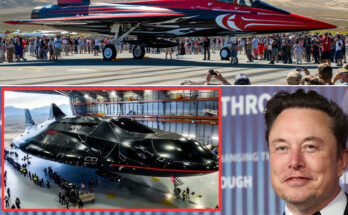In August 2021, Chinese scientists achieved a significant milestone in aviation technology by conducting a successful test flight of a jumbo jet prototype that reached hypersonic speeds. The aircraft, which reached Mach 6.56—approximately 5,033 miles per hour—was developed by the Chinese Academy of Sciences. This 20-minute flight, conducted at the Jiuquan Satellite Launch Center in the Gobi Desert, marked a pivotal moment in the pursuit of high-speed air travel.

Source: Military Aerospace

The Prototype: Design and Innovation
The aircraft, known as the Yunxing (“Cloud Rider”), features a distinctive design that sets it apart from traditional hypersonic vehicles. Unlike the slender, missile-like shapes commonly associated with hypersonic crafts, the Yunxing boasts a broad, rounded fuselage with cape-shaped wings mounted atop the body. This unconventional design aims to address the challenge of maintaining usable interior space at high speeds, a limitation that has historically confined hypersonic technology to military applications such as missiles and unmanned vehicles.

One of the core innovations of the Yunxing’s design is the attachment of wide wings on top of the fuselage like a cloak. This unique configuration converts the downward pressure generated by high-speed travel into upward lift, addressing the issue that at high speeds, the front of the airframe must withstand large downward pressure, affecting the vehicle’s ability to fly at high altitudes.
The Test Flight: Achieving Hypersonic Speeds
The test flight, conducted in August 2021, was initially kept confidential due to its sensitive nature. During the 20-minute flight, the Yunxing prototype reached a top speed of Mach 6.56, over six times the speed of sound. This achievement demonstrated the feasibility of the aircraft’s design and addressed significant challenges faced by aircraft designers, particularly the issue of maintaining usable interior space at hypersonic speeds.
Implications for Future Air Travel
The successful test flight of the Yunxing prototype represents a significant step toward the development of commercial hypersonic aircraft. If further developed, such aircraft could potentially reduce travel times between major cities to under two hours, revolutionizing global air travel. For instance, a flight from Beijing to New York, which currently takes over 13 hours, could be completed in approximately two hours.
However, several challenges remain before hypersonic commercial travel becomes a reality. Issues related to power, materials, and structural integrity at high speeds must be addressed. Additionally, the economic feasibility of such technology, including fuel costs and environmental impact, will be critical factors in its development and potential adoption.
Global Context: Hypersonic Developments

China’s advancements in hypersonic technology are part of a broader global interest in developing high-speed air travel. Other nations, including the United States, are also investing in hypersonic research. For example, Lockheed Martin is developing the SR-72 “Darkstar,” a hypersonic aircraft designed to achieve speeds up to Mach 6.0. These developments indicate a competitive landscape in the pursuit of hypersonic flight capabilities.
What is Hypersonic Flight?
Before delving into the specifics of this test, it’s important to understand what constitutes “hypersonic” flight. Hypersonic speeds are typically defined as those that exceed Mach 5, or five times the speed of sound. For reference, Mach 1 is the speed of sound, roughly 1,225 kilometers per hour (about 761 miles per hour) at sea level. Mach 5, therefore, represents a speed of around 6,125 kilometers per hour (3,836 miles per hour).
Aircraft that achieve hypersonic speeds are considered to be operating within an entirely new class of aviation technology. The advantages of such speeds could revolutionize global transportation, significantly reducing the time it takes to travel from one location to another. Furthermore, hypersonic technology has military applications, offering the potential for faster missile systems and more effective defense mechanisms.
Key Challenges of Hypersonic Flight

Designing and developing aircraft that can fly at hypersonic speeds is no small feat. Engineers and scientists face a variety of challenges that have hindered the widespread development of such technologies. Some of the primary obstacles include:
- Extreme Heat: At speeds exceeding Mach 5, an aircraft experiences intense friction with the air. This generates extreme heat, which can reach thousands of degrees Celsius. Conventional materials used in aircraft construction would melt or break apart under such conditions, requiring innovative heat-resistant materials to be used.
- Aerodynamic Stability: The faster an aircraft flies, the more challenging it becomes to maintain aerodynamic stability. The high-pressure environment at hypersonic speeds requires careful design to ensure that the aircraft remains stable during flight, preventing it from veering off course or disintegrating.
- Propulsion Systems: Most conventional jet engines are unable to operate efficiently at hypersonic speeds. For such speeds, specialized propulsion systems are required, such as scramjets (supersonic combustion ramjets), which are designed to function at extremely high velocities.
- Material Strength: The structure of hypersonic aircraft must be made from materials that can withstand not only the intense heat but also the extreme pressure and forces generated during flight. This calls for the development of advanced composites and alloys that can endure these harsh conditions.
- Control and Navigation: At speeds of Mach 6 and above, precise control and navigation become significantly more difficult. Small changes in the aircraft’s position can lead to large deviations in its flight path, requiring highly advanced control systems to maintain stability.

China’s Hypersonic Jumbo Jet Prototype
The Chinese Academy of Sciences has been at the forefront of hypersonic flight research. The recent announcement about the jumbo jet prototype’s success provides a glimpse into the ambitious goals of the country’s aerospace sector. While details of the prototype’s design remain limited, it’s clear that China is pushing the boundaries of what is possible in aviation.
One of the most intriguing aspects of the test flight was the aircraft’s ability to reach Mach 6.56, a speed that places it well within the hypersonic category. Achieving such speeds is no small feat and suggests that China has developed highly advanced propulsion systems and materials capable of withstanding the intense pressures and temperatures associated with hypersonic flight.
Project leader Cui Kai, in his speech accompanying the video, emphasized that the 20-minute test flight was a critical step in overcoming key technical challenges. By testing the aircraft under real-world conditions, scientists were able to gather valuable data that will inform future designs and improvements.
The flight also showcased the potential for jumbo-sized hypersonic aircraft, which could drastically reduce travel times between major cities. For instance, a flight from Beijing to New York could be completed in just over an hour, a drastic reduction from the typical 12-hour commercial flight.
The Future of Hypersonic Aviation
The success of the Chinese prototype has far-reaching implications for both civilian and military aviation. On the civilian side, the development of hypersonic commercial aircraft could lead to a new era of ultra-fast travel. However, significant hurdles still remain before such technology becomes available to the public. The aircraft would need to be made safe, efficient, and cost-effective for mass transportation.
Hypersonic flight could also have military applications, particularly in the development of faster missiles and weapons systems. Hypersonic missiles are incredibly difficult to intercept due to their high speeds, making them a potential game-changer in modern warfare. The ability to reach targets quickly and accurately could dramatically alter military strategies and defense systems.
China’s success also signals that other countries will likely intensify their efforts in hypersonic technology. The United States, Russia, and other global powers have been investing heavily in this field, which has led to significant advancements in both research and testing. The Chinese achievement may now spur more rapid development across the world, resulting in a new space race for hypersonic technologies.
Get Ready for Takeoff
Want to be the first to know about the latest aircraft and fighter jet news? Our newsletter has you covered. Enter your email address below and get ready for takeoff.
Implications for Global Aviation and Aerospace Industries
The race to develop hypersonic technology is not just limited to military applications but also holds immense potential for transforming global travel and commerce. If commercial hypersonic flights become feasible, it could revolutionize the aviation industry by cutting travel times to a fraction of what they are today.
For example, if a passenger jet could fly from London to Tokyo in under two hours instead of the current 12-hour journey, the implications for business, tourism, and global trade would be profound. Such advancements would also make global connections more accessible and foster increased cultural and economic exchanges.
Additionally, the implications for space travel are noteworthy. Hypersonic technology could serve as a stepping stone toward the development of reusable spacecraft, making space travel more affordable and frequent. The increased interest in hypersonic flight could, in turn, drive innovation in the aerospace industry as a whole.

Conclusion
The successful test flight of China’s hypersonic jumbo jet prototype represents a major leap forward in aviation technology. While many challenges remain, this achievement underscores the rapid advancements being made in the field of hypersonics. As China continues to push the boundaries of what is possible, the global aviation and aerospace industries are likely to see significant innovations that could change the way we travel and interact with the world.



